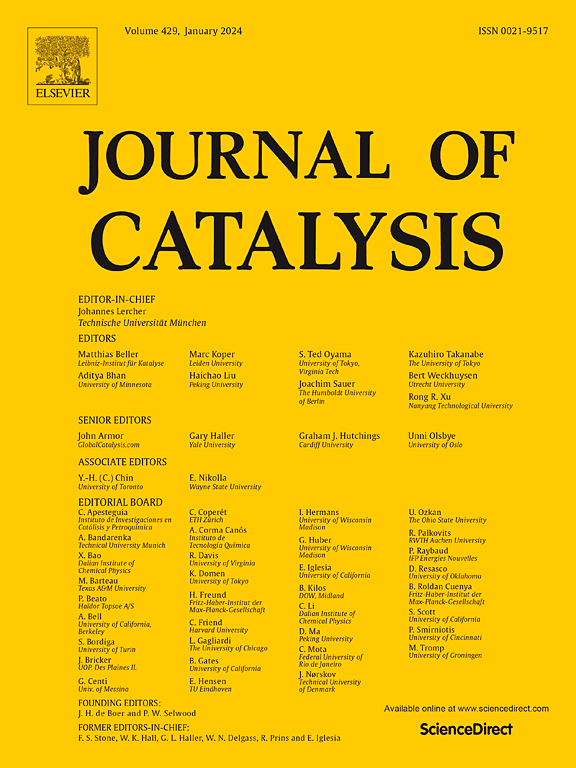Work-function-mediated unidirectional charge flow enables 139-fold enhanced photocatalytic hydrogen evolution on g-C3N4
IF 6.5
1区 化学
Q2 CHEMISTRY, PHYSICAL
引用次数: 0
Abstract
Suppressing photogenerated carrier recombination remains a pivotal challenge in photocatalyst design. In this work, we strategically integrate Co3O4 as a hole-extracting layer and Ni as an electron-trapping cocatalyst onto graphitic carbon nitride (g-C3N4), establishing a work-function-gradient-driven charge transport pathway along the Co3O4 → g-C3N4 → Ni directional cascade, resulting enhanced carrier concentration and charge migration kinetics. The optimized 1.5 %Ni-1 %Co3O4-C3N4 achieves a remarkable photocatalytic hydrogen evolution rate of 16.71 μmol h−1, surpassing 1 %Co3O4-C3N4 (5.17 μmol h−1), 1.5 %Ni-C3N4 (1.64 μmol h−1) and g-C3N4 (0.12 μmol h−1) by 3.2, 10.2 and 139.2 times, with robust stability over multiple cycles. Photoelectric characterizations confirm accelerated charge separation via synergistic electron transfer by Ni electron sinks and Co3O4 hole extractor. Density functional theory reveals work function gradient of Co3O4, g-C3N4, and Ni driving unidirectional electron flow from Co3O4 to Ni active sites via g-C3N4 as bridge, while an upward-shifted Ni d-band center and optimized hydrogen adsorption energy (ΔG*H) of 1.5 %Ni-1 %Co3O4-C3N4 enhance *H reduction kinetics. This work establishes a work-function-gradient based strategy for advancing solar-to-hydrogen conversion technologies.


工作功能介导的单向电荷流使g-C3N4的光催化析氢能力增强了139倍
抑制光生载流子复合仍然是光催化剂设计中的关键挑战。在这项工作中,我们战略性地将Co3O4作为空穴提取层和Ni作为电子捕获助催化剂集成到石墨氮化碳(g-C3N4)上,建立了沿Co3O4 → g-C3N4 → Ni定向级联的工作函数梯度驱动的电荷传输途径,从而提高了载流子浓度和电荷迁移动力学。1.5优化 % Ni-1 % Co3O4-C3N4达到显著的光催化氢进化率16.71 μ摩尔 h−1,超过1 % Co3O4-C3N4(5.17 μ摩尔 h−1),1.5 % Ni-C3N4(1.64 μ摩尔 h−1)和g-C3N4(0.12 μ摩尔 h−1),3.2,10.2和139.2倍,与鲁棒稳定性在多个周期。光电表征证实了Ni电子汇和Co3O4空穴萃取剂通过协同电子转移加速了电荷分离。密度泛函理论表明,Co3O4、g-C3N4和Ni的功函数梯度通过g-C3N4作为桥接驱动Co3O4向Ni活性位点的单向电子流,而Ni d带中心上移和优化后的氢吸附能(ΔG*H)为1.5 %Ni-1 %Co3O4- c3n4增强了*H还原动力学。这项工作建立了一个基于工作功能梯度的策略来推进太阳能到氢的转换技术。
本文章由计算机程序翻译,如有差异,请以英文原文为准。
求助全文
约1分钟内获得全文
求助全文
来源期刊

Journal of Catalysis
工程技术-工程:化工
CiteScore
12.30
自引率
5.50%
发文量
447
审稿时长
31 days
期刊介绍:
The Journal of Catalysis publishes scholarly articles on both heterogeneous and homogeneous catalysis, covering a wide range of chemical transformations. These include various types of catalysis, such as those mediated by photons, plasmons, and electrons. The focus of the studies is to understand the relationship between catalytic function and the underlying chemical properties of surfaces and metal complexes.
The articles in the journal offer innovative concepts and explore the synthesis and kinetics of inorganic solids and homogeneous complexes. Furthermore, they discuss spectroscopic techniques for characterizing catalysts, investigate the interaction of probes and reacting species with catalysts, and employ theoretical methods.
The research presented in the journal should have direct relevance to the field of catalytic processes, addressing either fundamental aspects or applications of catalysis.
 求助内容:
求助内容: 应助结果提醒方式:
应助结果提醒方式:


